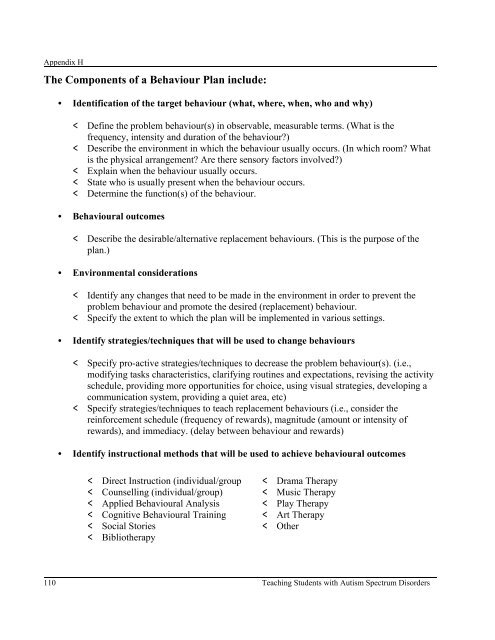Teaching Students with Autism Spectrum Disorders
Teaching Students with Autism Spectrum Disorders
Teaching Students with Autism Spectrum Disorders
Create successful ePaper yourself
Turn your PDF publications into a flip-book with our unique Google optimized e-Paper software.
Appendix H<br />
The Components of a Behaviour Plan include:<br />
• Identification of the target behaviour (what, where, when, who and why)<br />
< Define the problem behaviour(s) in observable, measurable terms. (What is the<br />
frequency, intensity and duration of the behaviour?)<br />
< Describe the environment in which the behaviour usually occurs. (In which room? What<br />
is the physical arrangement? Are there sensory factors involved?)<br />
< Explain when the behaviour usually occurs.<br />
< State who is usually present when the behaviour occurs.<br />
< Determine the function(s) of the behaviour.<br />
• Behavioural outcomes<br />
< Describe the desirable/alternative replacement behaviours. (This is the purpose of the<br />
plan.)<br />
• Environmental considerations<br />
< Identify any changes that need to be made in the environment in order to prevent the<br />
problem behaviour and promote the desired (replacement) behaviour.<br />
< Specify the extent to which the plan will be implemented in various settings.<br />
• Identify strategies/techniques that will be used to change behaviours<br />
< Specify pro-active strategies/techniques to decrease the problem behaviour(s). (i.e.,<br />
modifying tasks characteristics, clarifying routines and expectations, revising the activity<br />
schedule, providing more opportunities for choice, using visual strategies, developing a<br />
communication system, providing a quiet area, etc)<br />
< Specify strategies/techniques to teach replacement behaviours (i.e., consider the<br />
reinforcement schedule (frequency of rewards), magnitude (amount or intensity of<br />
rewards), and immediacy. (delay between behaviour and rewards)<br />
• Identify instructional methods that will be used to achieve behavioural outcomes<br />
< Direct Instruction (individual/group<br />
< Counselling (individual/group)<br />
< Applied Behavioural Analysis<br />
< Cognitive Behavioural Training<br />
< Social Stories<br />
< Bibliotherapy<br />
< Drama Therapy<br />
< Music Therapy<br />
< Play Therapy<br />
< Art Therapy<br />
< Other<br />
110 <strong>Teaching</strong> <strong>Students</strong> <strong>with</strong> <strong>Autism</strong> <strong>Spectrum</strong> <strong>Disorders</strong>

















